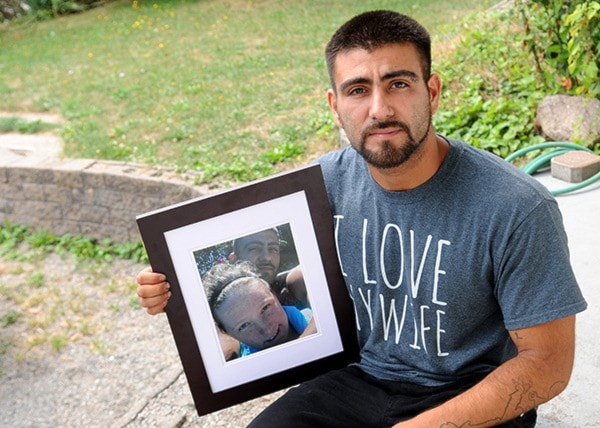Heather was a mother of three who loved to bake and would volunteer at her oldest daughter’s school.
She didn’t look anything like a stereotypical drug user, but in the early-morning hours of June 30, her husband Boris found his common-law wife, who occasionally used heroin, slumped on the living room carpet.
The paramedics who rushed to the house while Boris tried to revive his wife would later tell him Heather, 27, had likely been dead for two hours. A toxicology report later showed that she had unwittingly inhaled methylfentanyl – an especially potent version of fentanyl – thinking it was heroin.
On Wednesday, Boris sat smoking a cigarette on the steps of the Abbotsford home he shared with his wife for years.
The deaths of several Vancouver-area people at the hands of fentanyl disguised as heroin in recent weeks have prompted public warnings. Boris wants the public to know the issue affects a wide spectrum of people in the community.
“People need to realize it doesn’t just affect a certain type of people,” he said.
His wife had began taking Oxycontin before moving onto heroin. After stopping using for several months, she had returned to the drug “off and on” after a failed early pregnancy left her in the hospital with physical and emotional discomfort. Boris said his wife lived an otherwise normal life, helping out at schools, baking, and taking photos with her camera.
To her daughters, aged two, four and six, she was “super-mom,” said her husband.
Today, he just wishes he could hold Heather again, and warns against judging a person for a decision they made.
“Sometimes you do choose it, but sometimes the cards just fall. It’s what’s easy, it’s what helps you cope with the situation at hand,” he said.
For some, those choices involve alcohol or marijuana. For others – even that person next door – it’s harder drugs. Boris pointed to the recent deaths of a North Vancouver couple from fentanyl.
He has his own history with narcotics, and has a criminal record. After a tough childhood, Boris said he turned to dealing drugs. Those activities would eventually leave him facing criminal charges on several occasions. He said his own drug of choice has been cocaine. His use had diminished in recent years, although he said he used cocaine for the first time in six months just a week before Heather’s overdose. He said he wasn’t sure how his wife obtained her drugs.
He had been working as a foreman at a construction site, although he’s currently on employment insurance as he works to deal with the aftermath of Heather’s death.
His personal history informs his thinking about the dangers of drugs that appear to be one substance, but are actually another.
“You’re not safe with whatever you do,” he said. “For all you know, you can do something today and be fine, and do the same thing tomorrow and it can kill you.”
Boris said he was asleep when his wife overdosed, and believes that he might have been able to save the woman he called the love of his life if he had been present.

A 10-minute drive away, Erica Thompson holds in her hand a small kit designed for just such a situation.
The case holds naloxone, the antidote to an overdose of opioids including heroin, fentanyl and oxycodone. Such overdoses kill by slowing or stopping the victim’s breathing, but naloxone counteracts that, restoring breathing and consciousness. (It doesn’t work for overdoses from non-opioid drugs like cocaine, alcohol, ecstasy or DHB.)
The naloxone is injected and is safe to administer. It’s been used for more than 40 years, but it’s only in recent years that service providers, with the assistance of a prescribing doctor, have been able to hand out the antidote directly to users of drugs.
For Thompson, a former heroin user herself who now is an outreach worker with the Warm Zone women’s outreach centre, being able to connect people with such a life-saving kit has been rewarding.
“Unnecessary deaths occur and we can prevent this,” she said.
In addition to having helped connect some 40 users with the prescription they need to obtain a naloxone kit, Thompson has also trained more than double that number – including the mothers and children of users – in the administration of the antidote. As many as 200 overdoses in British Columbia have been reversed, thanks to the program.
“Just having the ability to save your own child’s life or a friend is huge,” she said. “When I think of all the people I lost, it’s such a sense of relief and hope that so many people don’t have to die.”
Some hurdles remain, though. Because a prescription is required to possess naloxone, firefighters, police officers and the family and friends of users can’t carry it, although Health Canada is reviewing those restrictions, according to the British Columbia Centre for Disease Control.
For more information on naloxone, visit towardtheheart.com.
Thompson can direct those hoping to access a kit. She can be contacted at ericat@wrsfv.ca, or at the Warm Zone at 604-746-3301.
A fundraiser to help Heather’s children has also been set up at http://www.gofundme.com/heathersgirls.
The paper version of this story reported a woman who died from an overdose of methylfentanyl had injected the drug, which she believed to be heroin. She, in fact, inhaled the drug, as that was her normal method of consumption. The News apologizes for the error.
